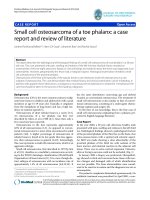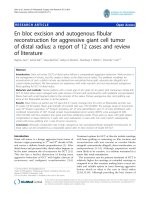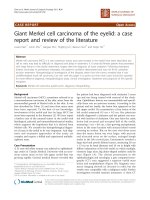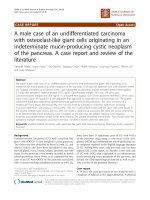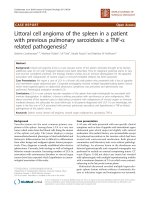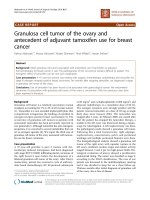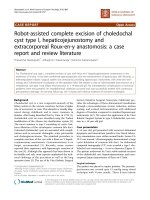Huge aneurysmal bone cyst secondary to giant cell tumor of the hand phalanx: A case report and related literature
Bạn đang xem bản rút gọn của tài liệu. Xem và tải ngay bản đầy đủ của tài liệu tại đây (5.18 MB, 6 trang )
Li et al. BMC Cancer
(2020) 20:233
/>
CASE REPORT
Open Access
Huge aneurysmal bone cyst secondary to
giant cell tumor of the hand phalanx: a
case report and related literature
Mingzhuo Li1, Yaokai Gan2*, Dingwei Shi2 and Jie Zhao2
Abstract
Background: Aneurysmal bone cyst (ABC) secondary to Giant Cell Tumor of bone (GCT) is a rare lesion, of which
the incidence is about 0.011 to 0.053 per 100,000 every year. There are only a few previous case reports, and most
of them occur in the spine, long bones or flat bones.
Case presentation: We report one case of a patient who complained of “progressive enlargement of the mass on
right-hand fifth finger for 5 years with ulceration for 6 months”. After the imaging examination in our hospital, it
was diagnosed as a “huge bone tumor on the proximal phalanx of the right-hand fifth finger”, then wide excision
and amputation of the fifth finger were made. The pathological examination diagnosed the mass as aneurysmal
bone cyst secondary to giant cell tumor, 13 × 8 × 6 cm3, with no local infiltration observed. No recurrence and
metastasis occurred 18 months after the operation, and the patient recovered well.
Conclusion: In this report, we discuss the etiology, diagnosis, differentiation, and management of Aneurysmal bone
Cyst secondary to Giant Cell Tumor of bone, and review previous case studies.
Keywords: Giant Cell Tumor of bone, Aneurysmal bone Cyst, hand short bone, huge bone tumor
Background
Giant cell tumor (GCT) of bone is a locally invasive
tumor, mostly benign, but with a distant metastasis rate
of 2% [1]. It is a common benign lesion in Asian, accounting for about 20% of all primary bone tumors.
Most of GCTs arise in the epiphysis and are commonly
found in the distal femur, proximal humerus, proximal
femur, and distal tibia. Only about 0.5% occur in the
hand [2], but the recurrence rate of them is higher than
that in other parts [3]. Aneurysmal bone cysts (ABCs)
account for about 5 to 6% of benign bone tumors [4]
and mostly occur in young people before the age of 20.
ABCs are considered primary lesions in approximately
70% of cases, with the remaining 30% arising secondary
* Correspondence:
2
Shanghai Ninth People’s Hospital, Shanghai Jiao Tong University School of
Medicine, Shanghai, China
Full list of author information is available at the end of the article
to different primary tumors. GCT is the most common
primary lesion to secondary ABCs, accounting for 19 to
39% [5], and about 80% of GCT secondary to ABC occur
in spine, long bones or flat bones [6]. According to the
literature, there are few cases of GCT secondary to ABC
occurring in the short bones of the hands or feet. This
patient has a long course of the disease, the tumor is
huge, and its clinical manifestation is not obvious. Additionally, the early stage is easily confused with other
bone diseases such as tophus, so the article reviews and
analyzes this case.
Case presentation
A 57-year-old man found a small mass on the proximal
phalanx of the right fifth finger 5 years before. It was initially peanut-sized and slowly progressing without any
discomfort like pain. About 1 year before, the mass increased rapidly and the patient went to another hospital
© The Author(s). 2020 Open Access This article is licensed under a Creative Commons Attribution 4.0 International License,
which permits use, sharing, adaptation, distribution and reproduction in any medium or format, as long as you give
appropriate credit to the original author(s) and the source, provide a link to the Creative Commons licence, and indicate if
changes were made. The images or other third party material in this article are included in the article's Creative Commons
licence, unless indicated otherwise in a credit line to the material. If material is not included in the article's Creative Commons
licence and your intended use is not permitted by statutory regulation or exceeds the permitted use, you will need to obtain
permission directly from the copyright holder. To view a copy of this licence, visit />The Creative Commons Public Domain Dedication waiver ( applies to the
data made available in this article, unless otherwise stated in a credit line to the data.
Li et al. BMC Cancer
(2020) 20:233
Page 2 of 6
after half a year. Because of the gout history of the patient, the doctor considered the mass tophus, but no obvious effect appeared after drug therapy. 2 months
before, the mass has swollen to 13 × 8 × 6 cm3 (Fig. 1).
The surface was partially broken, with no pain, no neuralgia, no sensory disorder, no headache or dizziness, no
chest stuffy or shortness of breath, no nausea or vomiting, etc. It was initially diagnosed as a “huge bone tumor
on the proximal phalanx of the right-hand fifth finger”.
The patient has a history of smoking and drinking.
Upon physical examination, the mass on the ulnar of
proximal interphalangeal joint of right-hand fifth fingers was
about 13 × 8 × 6 cm3, tough touched, with slight tenderness,
surface ulceration, a little bloody exudation, and no purulent
secretions. The skin over the mass was warm, and the feeling and movement of the finger were normal. The axillary
lymph nodes and supraclavicular lymph nodes were not
swollen. The remaining bones of the limbs had no subcutaneous nodules. The liver and spleen were of normal sizes
and there was no abnormality in the heart, lung, and brain.
X-ray plain (Fig. 2) of the right upper limb was performed. Right-hand fifth finger proximal phalanx bone
destruction was seen, with swelling, bubble-like changes
and local reticular shadow, accompanied by soft tissue
swelling. Adjacent phalanx bone structure stayed clear.
Fig. 2 X-ray plain shows bone destruction, with swelling, bubble-like
changes and local reticular shadow, accompanied by soft
tissue swelling
Fig. 1 A huge mass can be seen at the proximal of right hand fifth
finger, about 13 × 8 × 6 cm3, the surface collapsed, with a little
bloody exudation
Computed tomography (CT) three-dimensional imaging (Figs. 3 and 4) showed the mass on the right-hand
fifth finger was about 8.6 × 6.3 × 5.8 cm3. The bone shell
was thin. The multilocular cystic division and multiple
low-density shadows were seen. Osteolysis and bone
mineralization existed simultaneously. Part of the bone
cortex was discontinuous, but the periosteal reaction
was not obvious. A soft tissue mass was prominently deserved and the density of it was uneven, for the CT value
was from 13 to 45 HU. The marginal part of mass
bypassed the proximal interphalangeal joint and invaded
the right middle fifth phalanx. It is a pity that MRI was
not taken. X-ray of the chest revealed no pulmonary metastasis. Following laboratory tests, the blood uric acid
was observed to be at 400umol/L and other test results
were almost within the normal ranges.
The right-hand fifth finger interception combined with
giant bone tumor resection was taken under the general
anesthesia. Intraoperatively, the fifth metacarpal, phalanx, and tumor were completely removed. Histopathological findings revealed features of GCT with ABC
(Figs. 5 and 6). As we can see, there are lots of mononuclear ovoid cells and multinucleated giant cells, and
the big cell nuclei of them are mostly vacuolar. In another picture, the capsule wall of aneurysmal bone cyst
Li et al. BMC Cancer
(2020) 20:233
Page 3 of 6
bone tumors in the Western population, and only 2–5%
occurs in the phalanges [6]. Athanasian reported 13
cases of giant cell tumor on the phalanges, the clinical
manifestation was mainly swelling (85%) and pain (62%),
and some were found through physical examination
(54%), fewer patients got pathological fractures (9%) [3].
Wold and Swee pointed out 13% of patients had multicentric giant-cell tumor [7]. Two of the 28 patients with
giant cell tumor of the phalanx reported by Averill et al.
had lung metastases [8]. Therefore, the CT of the chest
and whole-body bone scans are considered as necessary
examinations for the patient.
Histologically, giant cell tumor of bone is composed of
mononuclear ovoid and spindle-shaped cells associated
with multinucleated giant cells and macrophages [6].
The lesions were graded according to the appearance of
the stroma and the giant-cells. Averill [8] et al. reported
28 cases, of which 12 were grade I, 3 were mixed of
grade I and II, 4 were grade II and 9 were grade III.
Among the common treatments, the recurrence rate of
curettage alone or curettage with bone grafting was 79%,
and the recurrence rate of local resection and bone
grafting, ray resection or amputation was 36%. Radiation
resection and extensive resection are deemed to be the
most effective methods [8].
Fig. 3 Coronal CT shows swelling changes, the bone shell is thin.
The multilocular cystic division and multiple low-density shadows
was seen
and many small vessel walls can be seen, which is the
feature of ABCs. Macroscopically, the resected tumor
tissue was grey, red and white; no necrosis was observed.
Microscopically, the resected margin was tumor-free.
Immunohistochemistry results indicated that the tumor
cells were partly positive for Vim, KP-1, PGM-1, and
CD34, and negative for Des, MSA, P63, and CD45. The
Ki67 was about 10%.
Following surgery, the patient’s vital signs were stable,
and there was a small amount of exudation in the surgical incision. Due to the high skin tension of the local suture, the wound healing was a little poor, but the blood
supply of fingertips was good. After several dressing
changes the wound improved. No radiotherapy and
chemotherapy were required, for the pathology suggested a benign change. Every one-month follow-up observation was required, clinical and radiological
examinations, including palpation and plain radiography,
were performed. No local recurrence or distant metastasis were identified 18 months following surgery. The patient is in a good position now.
Discussion and Conclusions
Giant cell tumor of bone is a common local invasive
tumor, mostly benign, accounting for 5% of all primary
Fig. 4 CT three-dimensional reconstruction showed soap bubblelike, swelling changes, osteolysis and bone mineralization
existed simultaneously
Li et al. BMC Cancer
(2020) 20:233
Page 4 of 6
Fig. 5 Pathology shows giant cell tumor of bone with aneurysmal bone cyst, the wall of the aneurysm can be seen (× 20)
Aneurysmal bone cyst (ABC) was first described by Jaffe
and Lichtenstein [9] in 1942 and was named for its pathological manifestations. Histologically, it is characterized by
a cavernous vascular tumor ranging from a few millimeters to 1 to 2 cm in diameter, with intralesional communicating cavitations without blood clots. Typically,
microscopic analysis of ABC reveals hemorrhagic tissue
with cavitary spaces separated by fibrous septa composed
of spindle cells, inflammatory cells, and a smaller percentage of giant cells [10]. Aneurysmal bone cyst is a benign,
osteolytic, expansive, hemorrhagic and mostly solitary lesion, accounting for about 5 to 6% of benign bone tumors.
Aneurysmal bone cysts can occur in bones throughout the
body, especially in long bones (67%), spine (15%), and pelvis (9%). Frassica et al. reported 10 cases of ABC on phalanx, usually, patients felt pain (90%) and swelling (40%)
and a few pathological fractures happened (10%) [11].
At present, the treatments of primary aneurysmal bone
cysts mainly include nutritional vascular embolization,
lesion scraping, surgical resection, and autologous bone
transplantation. In the report of Frassica et al., the recurrence rate of lesion scraping and autologous bone graft
is high, about 57.1%. 3 patients with complete bone resection and no recurrence happened [11].
Fig. 6 The giant cell tumor-like changes can be seen (× 200), and the arrows refer to the bone giant cells
Li et al. BMC Cancer
(2020) 20:233
Aneurysmal bone cyst secondary to giant cell tumor
mostly occurs in patients of 20 to 40 years [12]. Recent
studies suggest that secondary aneurysmal bone cysts
may be related to factors such as hyperemia and dilatation of the vascular bed [13] or induced vascular bed
caused by arteriovenous malformation of primary lesions
[14]. Patients often present with intermittent pain, soft
tissue mass, limited joint activity, etc. The incidence of
pathological fracture is larger than that of patients with
primary giant cell tumor of the bone [15].
Imaging examination is an important diagnostic tool
for GCT and ABC. It is difficult for a simple X-ray
examination to find two lesions, so CT and MRI are necessary supplements. CT typically revealed a characteristic soap-bubble appearance, and a balloon-like,
multilocular lytic lesion. Pathologic fracture was a common finding. Magnetic resonance (MR) imaging revealed
a mass with a fluid-fluid interface with hypointense signals on T1-weighted imaging (T1WI) and hyperintense
signals on T2-weighted imaging (T2WI) with contrast
enhancement of the septa. The presence of a double
density fluid level within the lesion was often seen [12].
Histopathologically, ABC secondary to GCT shows
two lesions at the same time microscopically, which is
the basis for diagnosis. The treatment of ABC secondary
to GCT is usually focused on the treatment of the bone
giant cell tumor. The surgical method should be determined according to the degree of malignancy, location
and peripheral invasion or not of bone giant cell tumor
[16].
Identification with finger tophus: tophus is the white
crystalline substance within the subcutaneous tissues or
associated with joints and tendons, which can infiltrate
the joint or tendon tissue and show sodium urate crystal
under polarized light microscopy [17]. Typical sites for
tophus deposition are well recognized including the
olecranon bursa, the Achilles tendon, the first metatarsophalangeal joint, the ear and the finger pulps. The tophus is often multiple [18] and can cause joint damage,
ankylosis, and others. Tophus is usually found in patients with a history of gout for more than 10 years without treatment [16]. On the X-ray plain, the tophus is
often characterized by joint destruction, soft tissue swelling around the joint, and local uplift. In this case, the patient got hyperuricemia about 4 years ago. The location
and clinical manifestations of the mass were similar with
those of tophus. But such a huge tumor didn’t erode the
joint, and the other limbs had no subcutaneous nodules,
which can be the point distinguishing from tophus.
Differentiation from primary malignancy in giant cell
tumor of bone (PMGCT): As is reported by Franco Bertoni [19], PMGCT is extremely unusual, there are only 5
PMGCTs in 924 patients diagnosed by GCT. Pain (4
cases) and swelling (2 cases) were the most common
Page 5 of 6
symptoms of the malignancies. All PMGCTs appeared
on plain films as osteolytic lesions with wellcircumscribed margins in the epiphyses of long bones.
An area of less distinct margins was present in two
cases, and cortical breakthrough was observed in four
cases. A soft tissue mass was seen on plain films in two
of the five cases. In this case, the mass grows rapidly in
the last year, and the clinical manifestations are similar
with those of osteosarcoma. The density of lesion on CT
is uneven, bone destruction and bone regeneration exist
at the same time, so the mass may be diagnosed as the
malignant bone tumor. However, there is no obvious
periosteal reaction on the X-ray plain. The possibility of
malignant transformation may be low, and the diagnosis
can be confirmed by pathological examination.
In summary, medical history and imaging examination
are the main methods to identify the ABC secondary to
GCT. The pathological examination is the gold standard.
The surgical method should be determined according to
the state of bone giant cell tumor. This paper reports a
rare case of ABC secondary to GCT on the phalanx,
hoping to provide experience for early diagnosis and
treatment.
Abbreviations
ABC: Aneurysmal bone Cyst; GCT: Giant Cell Tumor;; CT: Computed
tomography; MRI: Magnatic Resonance Imaging; US: Ultrasonography;
DECT: Dual-energy computed tomography; PMGCT: Primary malignancy in
giant cell tumor of bone; VIM: Vimentin; PGM-1: Phosphoglucomutase-1;
CD34: Cell differentiation-34; MSA: Multiplication-stimulating factor
Acknowledgements
Our work is supported by Shanghai Ninth People’s Hospital and Medical
School of Shanghai Jiaotong University. We thank our patient who kindly
gave his consent for this publication. We thank Editorial Office of BMC
Cancer for editing the revised version.
Authors’ contributions
Conception and design: GYK; Manuscript writing: LMZ; Final approval: GYK,
SDW, ZJ; Pathological explorations: CY; Patient’s management: GYK, SDW. All
authors read and approved the final manuscript.
Funding
This study was supported by Shanghai Ninth People’s Hospital and Medical
School of Shanghai Jiaotong University. The funders have no role in the
study except for financial support.
Availability of data and materials
The data that support the findings of this study are available from Shanghai
Ninth People’s Hospital, but restrictions apply to the availability of these data,
which were used under license for the current study, and so are not publicly
available. Data are however available from the authors upon reasonable
request and with permission of Shanghai Ninth People’s Hospital. We make
sure identifying/confidential patient data should not be shared.
Ethics approval and consent to participate
We have got the patient’s informed consent, and the agreement of
Institutional Ethic Committee Office of Shanghai Ninth People’s Hospital. The
number is SH9H-2019-T49–1.
Consent for publication
Written informed consent was obtained from the patient for publication of
this case report and any accompanying images. A copy of the written
consent is available for review by the Editor of this journal.
Li et al. BMC Cancer
(2020) 20:233
Competing interests
The authors declare that they have no competing interests.
Author details
1
Shanghai Sixth People’s Hospital, Shanghai Jiao Tong University School of
Medicine, Shanghai, China. 2Shanghai Ninth People’s Hospital, Shanghai Jiao
Tong University School of Medicine, Shanghai, China.
Received: 18 July 2019 Accepted: 12 March 2020
References
1. Biermann JS, Adkins DR, Agulnik M, Benjamin RS, Brigman B, Butrynski JE,
Cheong D, Chow W, Curry WT, Frassica DA, et al. Bone cancer. J Natl Compr
Cancer Netw. 2013;11(6):688–723.
2. Niu X, Zhang Q, Hao L, Ding Y, Li Y, Xu H, Liu W. Giant cell tumor of the
extremity: retrospective analysis of 621 Chinese patients from one
institution. J Bone Joint Surg Am. 2012;94(5):461–7.
3. Athanasian EA, Wold LE, Amadio PC. Giant cell tumors of the bones of the
hand. J Hand Surg. 1997;22(1):91–8.
4. Errani C, Ruggieri P, Asenzio MAN, Toscano A, Colangeli S, Rimondi E, Rossi
G, Longhi A, Mercuri M. Giant cell tumor of the extremity: a review of 349
cases from a single institution. Cancer Treat Rev. 2010;36(1):1–7.
5. Rapp TB, Ward JP, Alaia MJ. Aneurysmal bone cyst. J Am Acad Orthop Surg.
2012;20(4):233–41.
6. Vergel De Dios AM, Bond JR, Shives TC, McLeod RA, Unni KK. Aneurysmal bone
cyst. A clinicopathologic study of 238 cases. Cancer. 1992;69(12):2921–31.
7. Wold LE, Swee RG. Giant cell tumor of the small bones of the hands and
feet. Semin Diagn Pathol. 1984;1(3):173–84.
8. Averill RM, Smith RJ, Campbell CJ. Giant-cell tumors of the bones of the
hand. J Hand Surg. 1980;5(1):39–50.
9. Jaffe HL, Lichtenstein L. Benign Chondroblastoma of bone: a
reinterpretation of the so-called calcifying or Chondromatous Giant cell
tumor. Am J Pathol. 1942;18(6):969–91.
10. Dabska M, Buraczewski J. Aneurysmal bone cyst. Pathology, clinical course
and radiologic appearances. Cancer. 1969;23(2):371–89.
11. Frassica FJ, Amadio PC, Wold LE, Beabout JW. Aneurysmal bone cyst:
clinicopathologic features and treatment of ten cases involving the hand. J
Hand Surg. 1988;13(5):676–83.
12. Wu Z, Yang X, Xiao J, Feng D, Huang Q, Zheng W, Huang W, Zhou Z.
Aneurysmal bone cyst secondary to giant cell tumor of the mobile spine: a
report of 11 cases. Spine (Phila Pa 1976). 2011;36(21):E1385–90.
13. Patel PJ, Demos TC, Lomasney LM, Rapp T. Your diagnosis? Aneurysmal
bone cyst. Orthopedics. 2005;28(5):428–511.
14. Arora SS, Paul S, Arora S, Kapoor V. Secondary jaw aneurysmal bone cyst
(JABC)--a possible misnomer? A review of literature on secondary JABCs,
their pathogenesis and oncogenesis. J Oral Pathol Med. 2014;43(9):647–51.
15. Song M, Dai W, Sun R, Liang H, Liu B, Wu Y, Ma K, Lu M. Giant cell tumor of
the patella with a secondary aneurysmal bone cyst: a case report. Oncol
Lett. 2016;11(6):4045–8.
16. Anchan C. Giant cell tumor of bone with secondary aneurysmal bone cyst.
Int J Shoulder Surg. 2008;2(3):68.
17. Chhana A, Dalbeth N. The gouty tophus: a review. Curr Rheumatol Rep.
2015;17(3):19.
18. Walke V, Ramraje S, Jadhao V. Cytodiagnosis of gouty tophus. Cytojournal.
2013;10:11.
19. Bertoni F, Bacchini P, Staals EL. Malignancy in giant cell tumor. Skelet Radiol.
2003;32(3):143–6.
Publisher’s Note
Springer Nature remains neutral with regard to jurisdictional claims in
published maps and institutional affiliations.
Page 6 of 6

